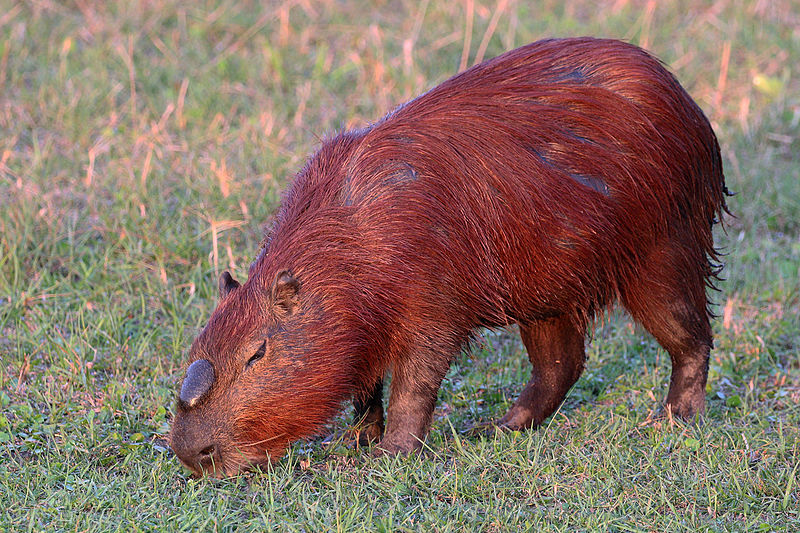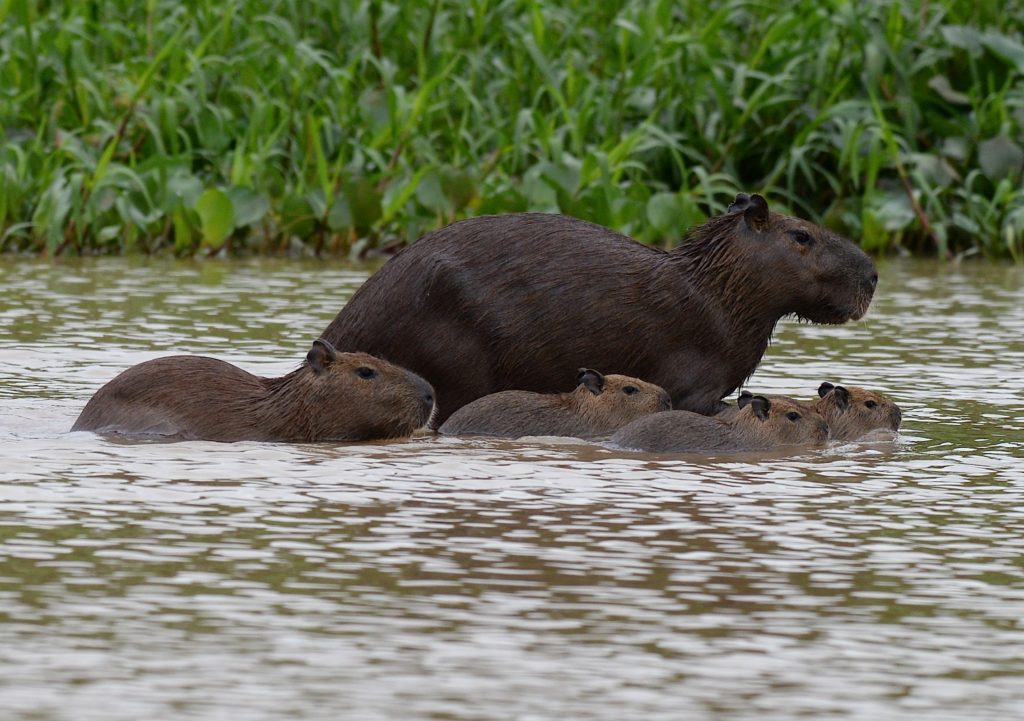Do you find the thought of a giant rodent off-putting? Do your thoughts go to huge rats running amuck in dark allies, threatening unsuspecting passers by?
I personally hold rodents in low esteem. Rats, mice…who needs them? With the exception of cavies. I spent countless hours as a child playing with guinea pigs. We had as many as 16 of these little rodents at one time (the males are very capable of chewing or climbing out of cardboard boxes to reach a female in the next box). The baby guinea pigs were very cute and the adults had quite pronounced personalities, and a lot of attitude.
It was this history with guinea pigs that made me interested in learning more about the largest rodent in the world, the South American capybara (Hydrochoerus hydrochaeris). These family-oriented herbivores are found in savannas and forested areas, living in groups of as many as 100 members. They are excellent swimmers and can remain underwater for as long as 5 minutes. In fact, capybara mate only in the water. (Perhaps it’s not surprising then that the South American alligator, the caiman, is one of the capybara’s greatest predators.)

With their squared-off nose and lack of tail, capybaras actually resemble guinea pigs. However, these oversized cavies weigh as much as 40 pounds. and can reach 24” at the shoulder, the size of an average standard poodle. Guinea pigs, on the other hand, weigh in at 2–3 pounds, and are 3–4” tall.
Their proportions make capybaras 60 times more massive than their closest relatives, rock cavies (Kerodon sp.) and 2,000 times more massive than the common mouse (Mus musculus). This tremendous size difference is why Herrera-Álvarez et al. took a closer look at the capybara, studying its propensity to develop cancer and other tradeoffs that would seem to coincide with its exceptional size.
Gigantism is a trait that capybaras share with elephants and blue whales. It describes any lineage of creatures that grows to a size remarkably larger than that of its close relatives, and continues to perpetuate this large size. Not just one individual, but the entire lineage becomes extraordinary in size.

We expect there to be tradeoffs for being extraordinarily large. Firstly, body size is known to have a negative correlation to population size. Selection of good traits is expected to be lower in a larger body, which should lead to an increased incidence of mutations.
Secondly, gigantism is achieved by an increased number of cells and higher rates of cell proliferation, which should increase the likelihood of cancer in giant animals like whales, elephants and capybaras.
But that’s not what we see in real life. The incidence of cancer in many gigantic animals is actually lower than what is theoretically expected, a phenomenon known as Peto’s paradox.
The authors of the BioRxiv article “How to make a rodent giant: Genomic basis and tradeoffs of gigantism in the capybara, the world’s largest rodent” looked at the genetic basis of gigantism in rodents, to uncover potential genetic signatures and related tradeoffs, by sequencing the genome of the capybara. Here are some of their findings.
What Constitutes a Giant Animal?
To determine whether the capybara is truly a giant, the authors used phylogenetic comparative methods, which showed that the rate of body mass evolution among caviomorph rodents has not been constant throughout their history. The ancestral size of the most recent common ancestor of caviomorpha was estimated to be 971g while the most recent common ancestor of the capybara and rock cavy was estimated at 1132g.
These results suggest that the rate of body evolution has undergone one or more sudden changes. The authors detected three shifts in the rate of body-mass evolution along the cavimorph tree. One shift was a decrease in the evolutionary rate, while the other two shifts showed increased rates, the largest rate shift being that of the most recent common ancestor of capybara and the Patagonian mara. (See the article for supporting evidence.)
Their results support the idea that capybaras evolved from a moderately small ancestor, comparable in size to a guinea pig, and that its large size today is the results of several evolutionary growth spurts.
Capybara Growth and Size Regulators
Animal growth is regulated by six signaling pathways: RTK via Ras, IIS via the PI3K pathway, Rheb/Tor, cytokine-JAK/STAT, Warts/Hippo and the Myc oncogene. The authors found that several genes within the IIS (insulin-insulin-like growth factor signaling) pathway exhibit signatures of divergence (LEP or leptin and PDX1 or pancreatic and duodenal homeobox 1) or to be under positive selection such as for PLAGL2 (Pleiomorphic adenoma-like Protein 2) and RFX6 (Regulatory Factor X6), indicating specialized evolution in capybaras.
In addition, they identified two gene families in the IIS pathway to be expanded significantly in the capybara compared to other rodents, specifically P13KR2 (Phosphatidylinositol 3-kinase Regulatory subunit) and PRKCI (atypical protein kinase C isoform PRKC iota).
The IIS pathway is important in pre- and post-natal growth, and its expansion in capybara is consistent with a larger body size via an increase in cell number. One example is LEP, a growth factor that regulates weight and bone mass via IIS pathway signaling. Another example, IGF-II, fuels pre- and post-natal growth, and has previously been show to remain detectable into adulthood in caviomorph rodents, making it a potential driver of gigantism in capybaras.
PDX1 and RFX6 are key transcription factors in the development of insulin-producing pancreatic beta cells. These transcription factors are crucial in both establishing and maintaining the identity and function of adult beta cells, where they regulate insulin gene transcription, content and secretion. Shifts in this transcription and secretion could be an important mechanism in the evolution of capybaras’ giant body size.
More Cells, Less Cancer?
Cancer incidence in wild-caught mice is as high as 46%, and 14–30% in guinea pigs. If increased cell proliferation is responsible for capybara’s increased size, they could potentially also have an increased risk of cancer. Yet there are only three reports of capybara cancer, a finding consistent with Peto’s Paradox. Thus the researchers searched capybaras for genes that enable cancer resistance.
Their search found three expanded gene families, TPT1 (Tumor protein, Translationally controlled 1), MAGEB5 (Melanoma Antigen Family B5) and GZMB (Granzyme B) in capybaras compared to other rodents. These three genes are all connected to tumor reversion and cancer suppression.
TPT1 plays a role in phenotypic cell reprogramming, and induces cell proliferation via mTOR pathway. TPT1 plays a role in tumor reversion, in cases where cancerous cells lose their malignant phenotype.
MAGE genes are expressed in proliferating cells such as those in placenta, tumors and germline cells. Normally these genes are deactivated in somatic cells, but when cells become neoplastic, MAGE genes reactivate, resulting in production of proteins that trigger a T cell-mediated tumor response and suppression.
GZMB is a component of the perforin/granzyme cell-mediated killing response of cytotoxic T cells via caspase-dependent apoptosis.
Evidence that capybara show diversification in T-cell receptor signaling, as well as expansion of MAGEB5 and GZMB gene families, suggests that T-cell-mediated tumor suppression may be a strategy to reduce the increased cancer risk expected with evolution of a giant body.
Conclusion
The authors note that studying evolution of a giant organism like the capybara can shed light on how biologic systems mitigate and even overcome the tradeoffs of their large size. You’ll want to dig into the paper further for details. Here is the full text:
Herrera-Álvarez, S. et al. (2018) How to make a rodent giant: Genomic basis and tradeoffs of gigantism in the capybara, the world’s largest rodent. BioRxiv doi: https://doi.org/10.1101/424606
